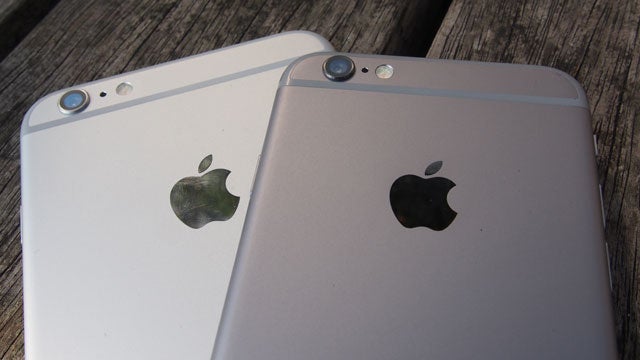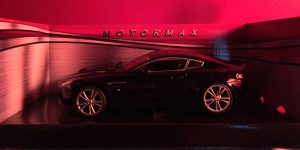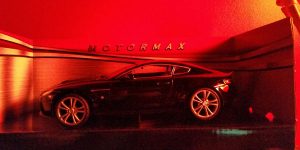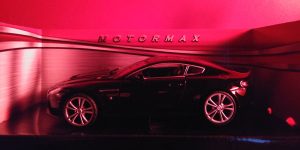Camera Test: iPhone 6 Plus vs Samsung Galaxy S5 vs LG G3

iPhone 6 Plus vs Samsung Galaxy S5 vs LG G3 camera shootout
In a follow up to our initial thoughts on the iPhone 6 and iPhone 6 Plus, we’ve tested the big iPhone against some of its closest competition to see how well the camera performs. The smartphones included in this shootout are the Samsung Galaxy S5 and the LG G3.
With the inclusion of phase detection AF, an upgraded processor and more intelligent image processing algorithms, we expected the iPhone 6 Plus to perform better than Apple’s previous devices. The only question was how much of a difference would the incremental improvements make in terms of real world image quality. This is what I found.
iPhone 6 Plus vs Galaxy S5 vs LG G3: Portraits with no HDR
I took a series of portrait shots, positioning the model (my mate Jamie) in a couple of different places that each present a different challenge for the cameras in terms of exposure and focus.
Backlit portraits are one of the toughest challenges for any camera, as there is a huge amount of variance in the density of light hitting the sensor, even more so when the sun is backlighting your subject.
Shooting with your subject’s back to the sun usually leaves images under exposed as the camera tries to compensate for the high contrasting scene – the bright sky, and your subject’s face in shadow.
These scenes are best-captured using HDR mode, but we’ve taken the pictures with and without to see how the cameras handle these situations by default.

iPhone 6 Plus with no HDR

Samsung Galaxy S5 with no HDR

LG G3 with no HDR
In these backlit portraits, the Samsung has completely overexposed the background and lost almost all of the detail and colour information in the sky, as well as the edges of the hair.
The iPhone 6 Plus and LG G3 do a better job of metering for the whole scene and still retain some of the cloud and sky detail. The image from the Samsung S5 is quite flat, despite being quite sharp. Of these images, the LG G3 has taken the most balanced shot.
Interestingly if you look very closely at the images from the G3, S5 and 6 Plus, you can see where the cameras are struggling to smooth out Jamie’s skin in spite of his facial hair. The result is the edges of his beard on his face appear somewhat smudged, particularly in the moustache area.
Winner: LG G3
iPhone 6 Plus vs Galaxy S5 vs LG G3: Portraits with HDR
Next, let’s take a look at a similar shot with HDR turned on to see how these cameras handle it.
iPhone 6 Plus with HDR

Samsung Galaxy S5 with HDR

LG G3 with HDR
When HDR mode is switched on the Samsung immediately shows some improvement, regaining the colour and background detail, HDR mode works by blending multiple pictures taken at different exposure settings to create an image with a greater dynamic range. As you can see, the highlights and shadows in Jamie’s hair and dark shirt are more apparent, especially around the collar area.
In HDR mode the iPhone 6 Plus has done the best job of replicating the warmth of the sun on Jamie’s back, it’s also done the best job of keeping the background detail. In HDR mode the S5 is noticeably sharper but I would say it looks over processed and unnatural.
While the LG G3 shows some colour shifting towards blue in HDR, if you look closely at his eyes, there’s a great amount of detail.
Winner: iPhone 6 Plus
iPhone 6 Plus vs Galaxy S5 vs LG G3: Facing the sun with HDR on
In these portraits the phones are having to balance the extreme intensity of direct sunlight on a subject’s face, a picture many of us take on our cameras all the time.

iPhone 6 Plus with HDR

Samsung Galaxy S5 with HDR
LG G3 with HDR
On first glance you can immediately see that the iPhone and the Samsung are struggling to produce a natural skin tone under this challenging condition, with the S5 helplessly bleaching Jamie’s face and the iPhone giving him a tango tan look.
Only the LG G3 has managed to replicate a natural looking portrait. But that isn’t the whole story, on closer inspection the LG is actually the softest image of the bunch suffering from some slight camera shake, followed by the 6 Plus, with the Samsung actually delivering the most detailed image.
This is a tough one to call, because image sharpness is important, but who wants a sharp image if your skin looks scorched or dunked in fake bake?
HDR mode helps the iPhone 6 Plus somewhat, while the Samsung S5 looks pretty much unchanged colour-wise and only really increases in sharpness to an unnatural proportion once again.
Winner: LG G3
iPhone 6 Plus vs Galaxy S5 vs LG G3: Sunset with no HDR
Everyone loves to take pictures of sunsets, so why not see how these cameras fair. In this condition, all of these phones are displaying strengths and weakness and at first glance, all have taken pretty attractive pictures.

iPhone 6 Plus (no HDR) sample

Samsung Galaxy S5 (no HDR) sample

LG G3 (no HDR) sample
I love the range of colours produced by the LG G3, most noticeable
when you compare colours of the sky reflected in the water on each
picture, the G3’s colours are more saturated, but not unpleasantly.
Where as the other two phones have tried to replicate what a blue sky
should look like, in reality the sky didn’t contain quite as much cyan
as their images suggest, it was more hazy and pink as the LG’s image
shows.
The S5 has once again delivered the sharpest looking
image, most noticeable when you look at the cranes on the left. But both
the LG and Samsung have underexposed the scene and lost the detail in
the darker areas, which is where the iPhone 6 Plus seems to shine in
terms of dynamic range, retaining more highlight and shadow detail than
the other two phones.
Winner: LG G3
iPhone 6 Plus vs Galaxy S5 vs LG G3: Sunset with HDR
Next, the same shot with HDR enabled. How does this change how the cameras perform.
iPhone 6 Plus (HDR) sample

Samsung Galaxy S5 (HDR) sample

LG G3 (HDR) sample
This scene is a great example of where HDR mode can make a difference
and once activated. The 6 Plus begins to show more of the pink haze in
the sky, as does the S5.
The Samsung actually shows the most drastic
improvement with HDR on, regaining pretty much all of the lost shadow
detail from the first picture, but once again, the resulting image is
overly sharpened and looks fake when you look closer.
The LG is improved
also but doesn’t quite match the detail and punch of the iPhone 6 Plus
in this condition when HDR mode is activated.
Winner: iPhone 6 Plus
iPhone 6 Plus vs Galaxy S5 vs LG G3: Low-light
Low-light is one of the areas where the Apple claimed the iPhone 6 Plus would really shine, with Optical Image Stabilisation, phase detection autofocus and improved noise handling algorithms and at first glance it appears it does indeed outperform the LG G3 and Samsung S5, although the LG G3’s laser autofocus focused noticeably faster than the other handsets under this condition, both of which use phase detection or focus pixels in “Applese”.

iPhone 6 Plus low-light sample

Samsung Galaxy S5 low-light sample

LG G3 low-light sample
The S5 is overwhelmed by the warm colours in this condition and over
saturates the scene, completely blending the top of the red box with the
red wall behind it. The G3 and 6 Plus both attempt to counter the
warmness of the scene and end up producing images with a slight purple
cast, most visible in the G3 image.
The iPhone 6 Plus shows good
dynamic range performance, retaining the best separation between the
box and the wall, as well as the shadows towards the left. However, it
doesn’t manage to fully capture the reflection highlights on the car,
bested by both the G3 and S5.
On close inspection, despite
appearing to deliver the clearest image, the iPhone 6 Plus doesn’t
appear to handle luminance noise quite as well as the LG G3 and slightly
smudges the details of the car in an attempt combat it. The S5 suffered
the most with noise under this lowlight condition and produces heavily
smudged details.
Winner: LG G3/iPhone 6 Plus – Tie
iPhone 6 Plus vs Galaxy S5 vs LG G3: Which is best?
Undoubtedly the iPhone 6 Plus shows some improvements over its predecessors, and outperformed the phones it was up against in this test in some areas. But my initial thoughts on the new camera features of Apple’s latest smartphones remain largely unchanged. Apple iPhones are known for taking good pictures, that’s nothing new. The iPhone 6 Plus does show some improvement over the previous iPhone, particularly in lowlight and dynamic range performance, but that is the least we could expect from the new iPhone.
When stood up besides the competition in this shootout, there’s no clear light between the iPhone 6 Plus, the LG G3 and the iPhone 5, and while I’d say the Samsung S5 isn’t quite on par with the rest, it produced the sharpest images in a number of conditions so it can’t be written off completely.
The fairest way to present my verdict, given the mixed results of all devices is to award a winner, with a small comment, on a number of key components that matter in smartphone photography.
Autofocus Speed: LG G3
Laser focusing for nearby subjects is noticeably snappier than those tested in this feature. Particularly in lowlight.
Taking a picture: LG G3 (Tied)
iPhones are known for taking pictures almost instantaneously, the LG G3 keeps up, while the Samsung S5 seems to take a brief moment to think about it. The LG G3’s camera shutter position on the back makes it the most comfortable and secure to use overall.
The iPhone 6 Plus feels awkward and at risk of slipping from the hand. When it comes to handling, the older (smaller) iPhones and the iPhone 6 are better than the iPhone 6 Plus.
Dynamic range: iPhone 6 Plus
The iPhone 6 Plus seemed to get the most out of shadowed areas and did the best at avoiding blown highlights.
Image processing: LG G3
Although the iPhone 6 Plus processed highlights and shadows better, the colours tones and saturation from the LG G3, as well as the sharpening were the most natural of those tested. I found the LG G3’s was the most effective at retaining detail overall.
Lowlight: LG G3 and iPhone 6 Plus (Tied)
Both cameras have attributions that help them take decent pictures in low-light, but the differences are so small that they’re only obvious when viewed at 100%.
Flash: iPhone 6 Plus
The True Tone Flash unit, also featured on the iPhone 5S, produced the least offensive on-camera flash results of those devices tested.
Capturing a steady picture: LG G3
Despite having O.I.S., the iPhone 6 Plus produced a number of shaky images, most noticeable when taking HDR shots. I would put this down to the awkwardness of taking a picture on such a large device. On a number of occasions I felt like I may drop it whilst trying to take a picture.
The LG G3 combats this somewhat by allowing you to press the shutter on the back of the phone, making it easier to hold it firmly in your hand, especially when taking selfies.
Consistency: iPhone 6 Plus
There were fewer surprises when taking pictures with the iPhone 6 Plus, even in the conditions when it didn’t do the best, it did the same thing each time.
Default camera interface: LG G3
All of the default camera options do well to avoid clutter, but I found it easier to change camera mode and settings using LG G3.
Battery life: LG G3
After taking pictures for a few of hours, the battery on the LG G3 had only fallen by 11%, the S5 had fallen by 14% and the iPhone 6 Plus had dropped by 18%.
Next, read our iPhone 6 vs iPhone 6 Plus
Thanks to Three for providing us with the iPhone 6 Plus to use in this camera test

